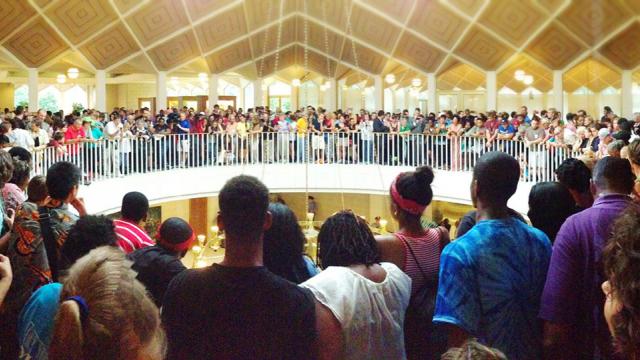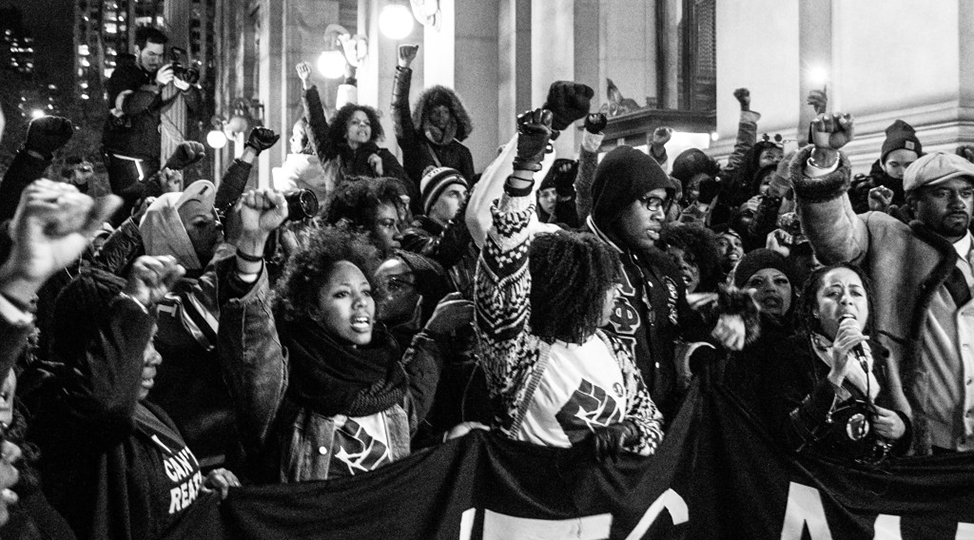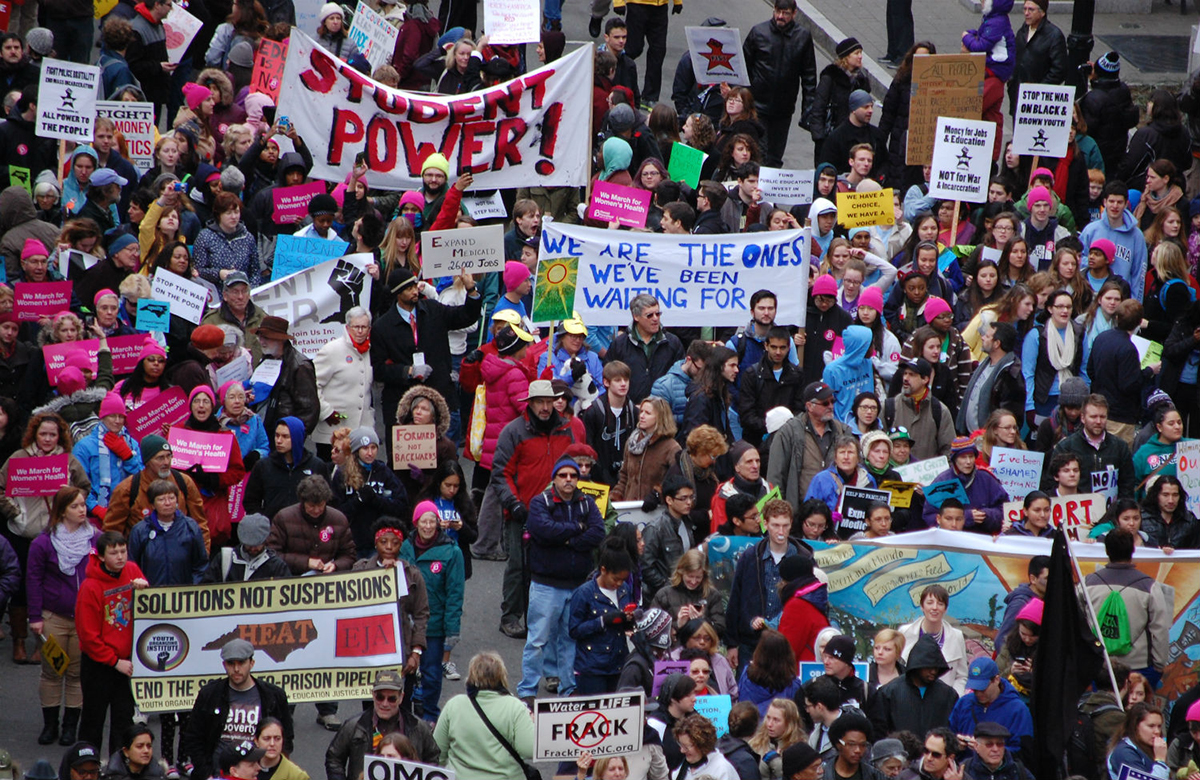
This is the third part in a three-part series highlighting the organizing efforts of Reverend William Barber and North Carolina's Forward Together movement. Read parts I and II.)
During a demonstration at the North Carolina state capitol rotunda in February, several dozen youth activists were outside legislative chambers demanding, among other things, affordable college tuition, a $15 an hour minimum wage, access to healthcare, and voting rights. State capitol police, who kept a heavy presence throughout the press conference and protest, told chant leaders that the noise from their protest was interrupting the legislative process and that they wouldn’t hesitate to arrest participants.
“How quiet do we have to be to express our First Amendment rights?” Asked Manju Rajendaran, one of the young activists present. Protesters cheered on her question. The officer in charge had no answer.
“How quiet do we have to be to express our First Amendment rights?” Rajendaran asked again, with conviction. The officer in charge turned away and returned to his original position.
“He didn’t give us a decibel level, so we’re gonna keep right on marching,” said Reverend William Barber, president of the North Carolina NAACP and the face of the Forward Together movement. The demonstration continued, with no arrests.
“We’re establishing new legal precedent every day,” Barber told Occupy.com. “We weren’t even allowed in here at the start of the session.”
Barber said when North Carolina’s Forward Together movement first started conducting mass civil disobedience actions in 2013, the youngest activists were the first ones to volunteer themselves to be arrested.
“Among first 17 people arrested, the first four were young people,” Barber said.
Forward Together – known locally as the Historic Thousands on Jones Street (HKonJ) coalition – has been organizing since 2007, when Democrats controlled North Carolina’s state government. As mentioned in the previous two articles of this series, HKonJ unites 170 different organizations around a 14-point agenda focused on economic, racial, educational, and environmental justice, along with guaranteed voting rights, access to reproductive healthcare, and a call to end overseas military occupations.
After North Carolina Republicans took over the state legislature in 2010 and the executive branch in 2012, multiple laws have been passed that endanger the state’s public universities, disenfranchise North Carolina voters, drive down workers’ wages, open up public land to fracking, and deny women access to reproductive healthcare (a federal court later overturned this), among others. HKonJ organized the internationally-known “Moral Monday” protests, which became one of the largest sustained civil disobedience campaigns in history, resulting in approximately 1,000 arrests (Full disclosure: I was one of the arrestees as part of my research for this story).
According to Rev. Barber, young people took an interest in the Forward Together movement because it was connecting those fundamental issues with the ways they will affect young North Carolinians several years into the future.
“A lot of these policies are directed at them and their generation,” Barber said. “Voter suppression is about 2020 and 2030."
"They’re not going to vote for people who cut education, who cut healthcare, who say they won’t raise the minimum wage,” Rev. Barber continued. “When young people see it in those terms, they understand it’s not right… That’s the beauty of youth. They can tell right from wrong.”
Manju Rajendaran said HKonJ’s success in consistently bringing out thousands of engaged citizens to protest these policies has been the result of a movement structure that welcomes the millennial generation – partly because it's free from traditional organizing obstacles and stiff tactics.
“Regardless of race, gender, sexuality, or immigration status, all of our struggles are interconnected,” Rajendaran said. “When we build a movement that can hold up people as indivisible beings who have multiple needs, it necessitates that we build movements that have diversified leadership, that have more democratic decision-making processes that better reflect the world we’re trying to build."
"It echoes a lot of the movements from the sixties. I think we’re borrowing from a strong tradition of nonviolent direct action," Rajendran continued.
At a time when established progressive organizations are asking about how to loop in today’s tech-savvy youth, some of Forward Together’s youth leaders stressed that the medium isn’t as important as the message itself.
“All media is just getting intensified. I don’t think people are throwing out their books,” said 21-year-old Denea Crowell, a junior at NC Central University. “As things continue to happen in the U.S. and our communities, people are becoming more conscious. Not only do they want to learn, they want to do something.”
According to 19-year-old Hakeem Dykes, a freshman at Shaw University, younger generations are becoming more turned on to independent media than ever before, simply because it devotes a greater portion of its coverage to stories young people are interested in.
“The people who give us this information in the mass media, there’s this a lack of awareness of what we want to see,” Dykes said. “When you tell [youth] and they become aware, they want to do more, they want to know what’s next.”
As more established progressive organizations and political groups struggle to bring in and engage younger audiences, Rev. Barber suggests appealing to their desire to do something big for the world that will have a multi-generational impact.
“Young people are drawn into a movement when they feel like they’re doing something that’s going to make a historical difference, that’s not mundane,” Rev. Barber said. “Don’t expect them to stick around for a meeting where you decide who the officers are and what color the napkins will be at a banquet.”
Rev. Barber’s advice for those groups hurting for young members?
“Listen to them, give them a seat at the table,” Barber said. “The NAACP is the only organization that has youth members elected by youth chapters on national board… Young people are not just pushed aside to hand out flyers for the movement, but are key to the foundational structure of it.”
3 WAYS TO SHOW YOUR SUPPORT
- Log in to post comments


















